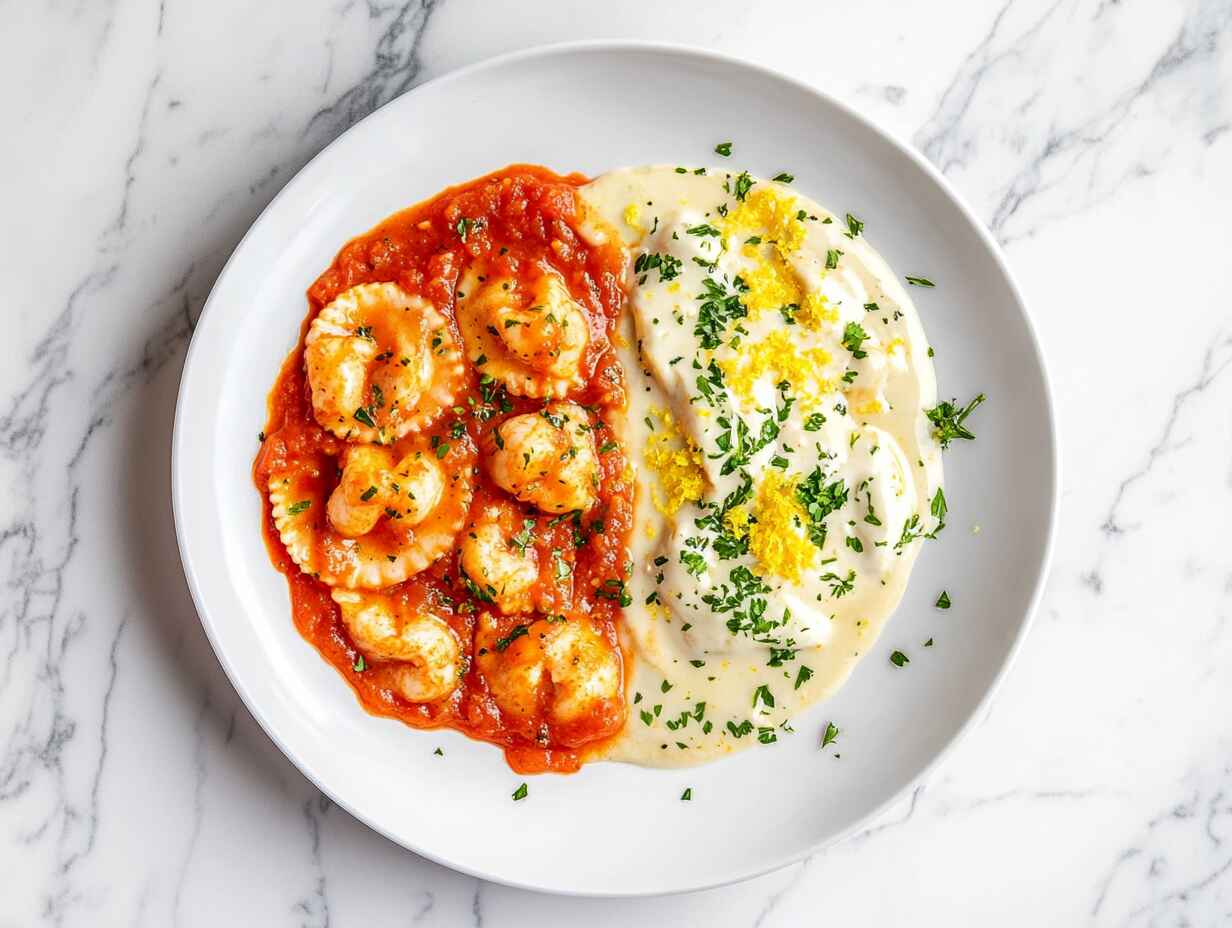There’s something magical about lobster ravioli – tender pockets of pasta filled with succulent lobster meat, often drizzled with a sauce that elevates every bite. But here’s the question: is lobster ravioli better with red or white sauce? This question has puzzled food enthusiasts and home cooks alike for years. The debate is real, and it’s more than just a matter of personal taste. The right sauce can make or break this delicate dish.
In this article, we’re going to dive deep into the world of lobster ravioli and explore the two most popular sauce choices: red and white sauces. We’ll talk about the unique flavors of each, the best ways to pair them, and some common problems people face when making these pairings. By the end, you’ll know exactly how to take your lobster ravioli experience to the next level. So, let’s get started!
Table of Contents
Why the Sauce Choice Matters for Lobster Ravioli
The sauce isn’t just an afterthought when it comes to lobster ravioli it plays a huge role in enhancing the flavors and textures of the dish. Imagine eating lobster ravioli without any sauce it would feel like something is missing, right? The sauce brings everything together, creating harmony between the pasta and the rich lobster filling. Choosing the wrong sauce can overwhelm the delicate flavors of the lobster or clash with the pasta’s texture.
Choosing between red and white sauce can be tricky. While both have their merits, the right sauce for your lobster ravioli depends on several factors: the flavor profile you’re aiming for, the occasion, and even dietary restrictions. So, let’s break down the characteristics of both sauces and see how they interact with lobster ravioli.
Overview of Lobster Ravioli and Its Popularity
Lobster ravioli is a dish that exudes sophistication, often served on special occasions or at upscale restaurants. It combines two beloved elements of Italian cuisine: ravioli (a classic pasta) and lobster (a luxurious seafood). The ravioli itself is typically stuffed with a mixture of lobster meat, ricotta cheese, and seasonings like garlic and herbs. The pasta is delicate yet sturdy enough to hold the flavorful filling without falling apart.
Over the years, lobster ravioli has become a popular dish not just in fine dining but also among home cooks looking to impress their guests. Whether you’re hosting a dinner party or treating yourself to a comforting meal, lobster ravioli is a fantastic choice. And the sauce? Well, that’s what can elevate this dish from great to extraordinary.
What Is Lobster Ravioli?
Before we jump into the sauce debate, let’s take a moment to appreciate what makes lobster ravioli so special. This dish focuses on harmonizing textures and flavors. The ravioli itself is made from soft, thin pasta that serves as the perfect vessel for the lobster filling inside.
Key Ingredients in Lobster Ravioli
Lobster ravioli is all about the quality of the ingredients used. Here are the key components:
- Pasta Dough: Typically made with flour, eggs, and a little bit of salt, the dough should be rolled thin to allow the filling to shine.
- Lobster Filling: Fresh lobster meat is the star of the show, often combined with ricotta cheese, garlic, lemon zest, and sometimes a bit of parsley for freshness.
- Seasonings: A delicate mix of herbs and spices think parsley, thyme, or even a pinch of saffron helps bring out the natural sweetness of the lobster.
How Lobster Ravioli is Made
Making lobster ravioli is a bit of a labor of love, but it’s totally worth the effort. The process typically starts with preparing the lobster filling. Fresh lobster meat is sautéed in butter with garlic and herbs, then mixed with ricotta cheese and seasonings to create a flavorful filling.
Next, you roll out the pasta dough thinly, cut it into squares, and place a small spoonful of the lobster mixture in the center. After sealing the edges, you have perfect little pockets of lobster goodness ready for cooking. The ravioli is then boiled until tender, typically for 2-3 minutes, until the pasta is soft and cooked through.
Exploring Red Sauce for Lobster Ravioli
Red sauce is a classic choice for many pasta dishes, and it’s no surprise that it pairs with lobster ravioli as well. But how does the rich, tangy taste of a tomato-based sauce complement the delicate flavors of lobster? Let’s find out.
Traditional Red Sauces and Their Flavor Profiles
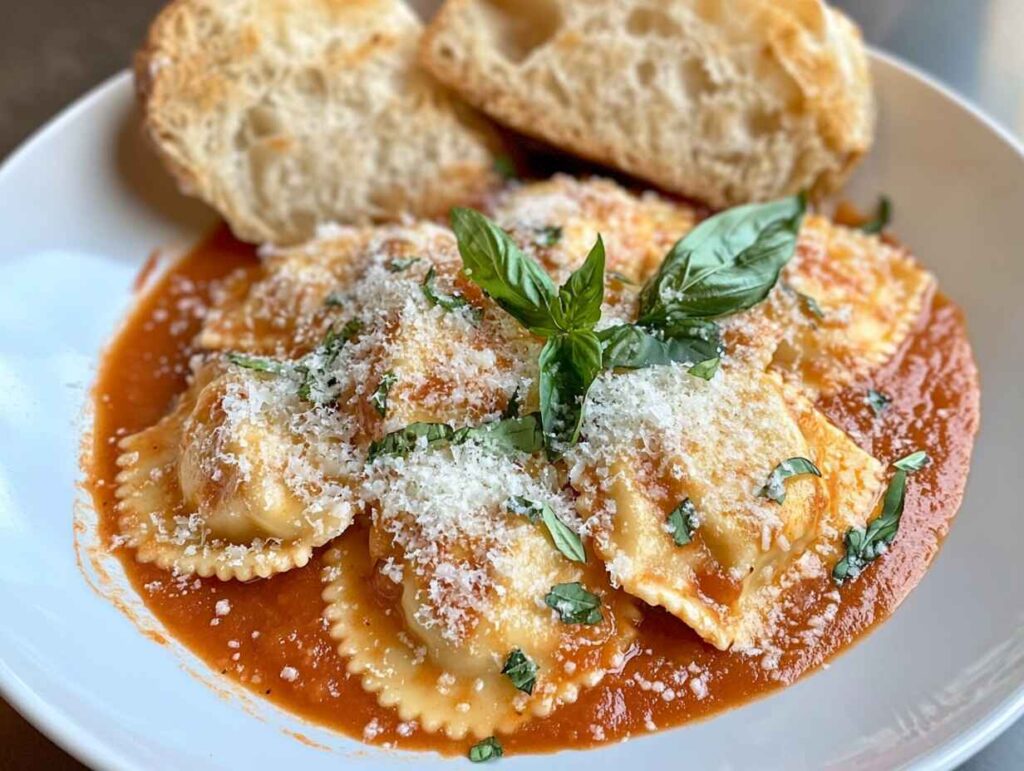
Red sauces are usually tomato-based and have a rich, bold flavor that can range from tangy and sweet to slightly spicy. Common red sauces like marinara or arrabbiata are made with tomatoes, garlic, onions, and herbs, giving them a slightly acidic taste. These sauces can bring a savory, robust flavor that complements heartier dishes.
How Tomato-Based Sauces Complement Lobster Ravioli
You might be thinking, “Lobster is a delicate seafood, and tomatoes can be pretty intense, right?” Well, that’s true, but when paired correctly, red sauces can enhance lobster ravioli in unexpected ways. The acidity from the tomatoes can help cut through the richness of the lobster filling, providing a balanced bite. The sweetness of the tomatoes can also highlight the subtle sweetness of the lobster meat, creating a harmonious flavor profile.
Common Red Sauces Used with Lobster Ravioli (Marinara, Arrabbiata, etc.)
There are many varieties of red sauces that can be paired with lobster ravioli. Here are a few common ones:
- Marinara: A simple, classic sauce made with tomatoes, garlic, and herbs. It’s mild and smooth, perfect for balancing out the richness of the lobster.
- Arrabbiata: A spicier version of marinara, made with red pepper flakes. If you like a little heat, this sauce adds a punch that contrasts nicely with the sweetness of the lobster.
- Pomodoro: A fresh, bright sauce made with ripe tomatoes, garlic, and olive oil. It’s lighter than marinara and can complement the lobster without overpowering it.
Pros of Pairing Lobster Ravioli with Red Sauce
Red sauce can be a great choice for lobster ravioli, especially if you’re looking for a contrast of flavors. Here are some advantages of pairing the two:
- Balance of Acidity: The acidity of the tomatoes cuts through the richness of the lobster filling, preventing the dish from feeling too heavy.
- Enhanced Lobster Flavor: The sweetness of the tomato sauce can bring out the natural sweetness of the lobster meat.
- Spice and Depth: For those who like a little spice, arrabbiata or other red sauces with heat can create an interesting contrast with the mildness of the lobster.
Possible Challenges with Red Sauce Pairings
While red sauce can work well with lobster ravioli, there are some challenges to consider:
- Overpowering Flavors: Some tomato-based sauces can be quite bold, and if not balanced correctly, they can overpower the delicate flavor of the lobster.
- Too Heavy: If the red sauce is too thick or rich, it can make the dish feel heavy and detract from the lightness of the ravioli.
Red sauce can definitely be a great option for lobster ravioli, but it requires careful consideration to avoid overpowering the dish. Now, let’s explore the other side of the sauce debate: white sauce!
Exploring White Sauce for Lobster Ravioli
If red sauce isn’t your thing, or you’re just curious about how white sauce pairs with lobster ravioli, you’re in the right place. White sauces, often creamy and rich, can be a luxurious choice for this delicate pasta. Let’s dive into the world of white sauces and see why they’re a popular option for lobster ravioli.
Creamy White Sauces and Their Flavor Profiles
White sauces are typically made from a base of cream, butter, and sometimes cheese. These sauces are smooth, rich, and comforting, with a soft, velvety texture that coats the ravioli beautifully. Classic white sauces like Alfredo, Bechamel, or even a simple cream sauce can work wonderfully with lobster ravioli. Their rich flavors complement the sweet, delicate lobster filling without overpowering it, providing a more subtle contrast compared to the acidity of a red sauce.
How Alfredo, Bechamel, and Other White Sauces Pair with Lobster Ravioli
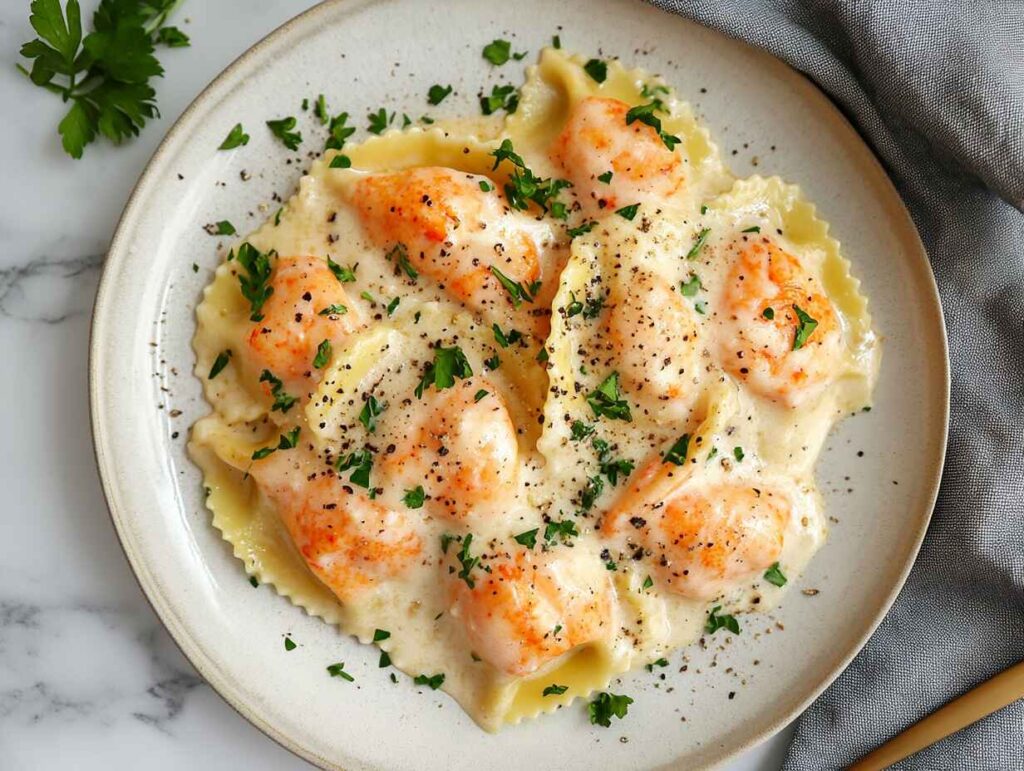
Let’s take a closer look at some of the most popular white sauces and how they pair with lobster ravioli:
- Alfredo: This classic sauce is made with butter, heavy cream, and Parmesan cheese. It’s rich and creamy, providing a luscious coating for the lobster ravioli. The mild flavor of Alfredo doesn’t compete with the lobster; instead, it enhances the overall richness of the dish.
- Bechamel: A velvety, white sauce made with butter, flour, and milk, Bechamel is one of the mother sauces of French cuisine. It’s smooth, subtle, and versatile. When used in lobster ravioli, Bechamel adds a silky texture and a creamy flavor that pairs beautifully with the lobster filling.
- Cream Sauce: A simple cream sauce made with heavy cream, garlic, and a little bit of cheese offers a decadent but not overwhelming flavor. It’s rich but still allows the lobster’s flavor to come through without being too heavy.
Pros of Pairing Lobster Ravioli with White Sauce
White sauce can be an excellent choice for lobster ravioli, and here are a few reasons why:
- Rich and Luxurious: White sauces are often rich and indulgent, which makes them a perfect match for the decadence of lobster ravioli.
- Subtle Flavor Balance: White sauces are typically less acidic than red sauces, so they provide a gentler contrast to the lobster’s delicate flavor, letting the seafood shine.
- Texture Enhancement: The creamy texture of white sauces adds an extra layer of indulgence, making each bite of ravioli melt in your mouth.
Factors to Consider When Choosing Between Red and White Sauce
When it comes to choosing between red and white sauce, it’s not always about personal preference it’s about finding the right balance of flavors and textures for the dish. Let’s explore the key elements to keep in mind when making your decision.
Flavor Compatibility with Lobster
The main thing to keep in mind is how the sauce will interact with the lobster. Lobster has a sweet, delicate flavor that’s easily overwhelmed by strong or acidic sauces. Red sauce, with its acidity and bold flavors, can sometimes overshadow the lobster, whereas a white sauce offers a gentler balance that allows the lobster’s sweetness to come through more clearly.
Texture and Consistency Considerations
The texture of the sauce also plays an important role. A smooth, creamy white sauce will coat the ravioli in a rich, velvety way, enhancing the overall mouthfeel. Red sauces, on the other hand, tend to be a bit more liquidy and tangy, providing a burst of flavor but not the same creamy indulgence. Think about whether you want your dish to feel rich and creamy or more vibrant and tangy.
Dietary Preferences and Restrictions
Another important factor to consider is any dietary preferences or restrictions. If you’re cooking for someone with a lactose intolerance, for example, a tomato-based red sauce might be a better option than a creamy white sauce. Similarly, if you’re looking for a lighter option, a red sauce could provide a fresher, less calorie-dense alternative to a rich white sauce.
Occasion and Presentation Considerations
The occasion can also influence your sauce choice. For formal dinners or special occasions, a luxurious white sauce might feel more refined and elegant. On the other hand, if you’re serving lobster ravioli for a casual family dinner or barbecue, a hearty red sauce might be more fitting and fun.
Is There a Middle Ground? Blending Red and White Sauces
If you’re torn between red and white sauce, why not try blending the two? Combining red and white sauces can offer the best of both worlds tangy tomato flavor balanced by creamy richness. Many Italian dishes embrace this concept, known as a “rosa” sauce, which blends marinara and cream for a beautifully balanced flavor profile.
The Concept of Combining Sauces for Lobster Ravioli
Blending red and white sauces allows you to get the acidity and brightness of tomatoes while still enjoying the creamy, indulgent texture of a white sauce. For example, a simple marinara sauce with a splash of heavy cream or a few spoonfuls of Bechamel can create a perfect balance of flavors for lobster ravioli.
Popular Hybrid Sauces for Lobster Ravioli
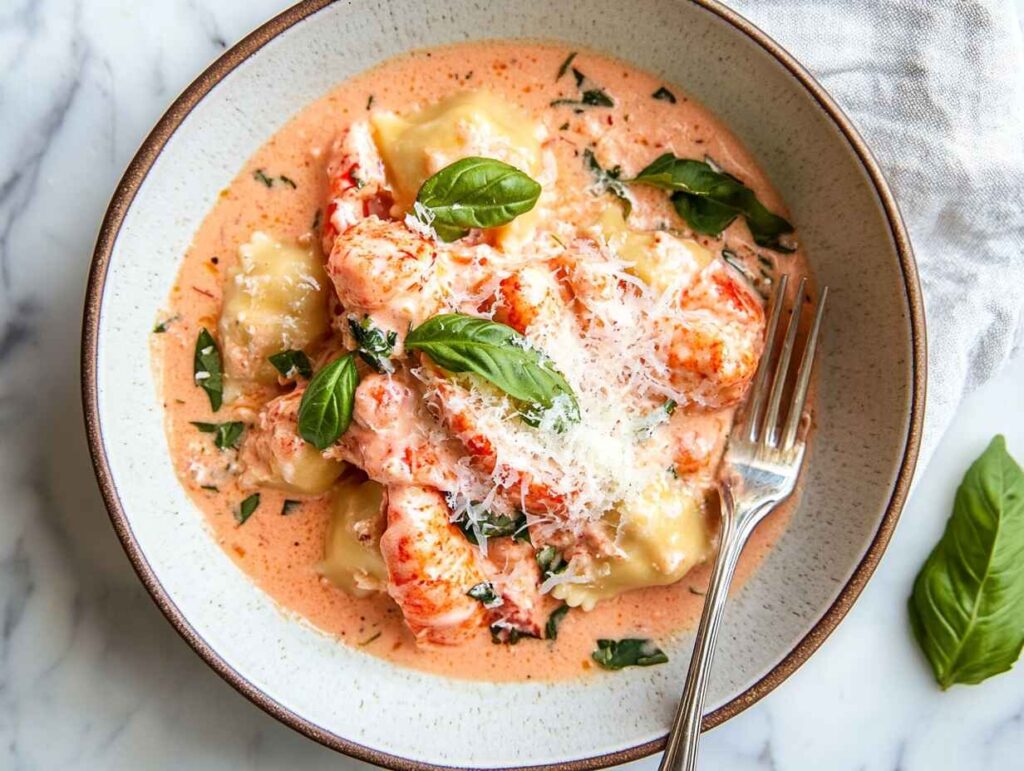
Here are a few hybrid sauce ideas you might want to try:
- Rosa Sauce: A 50/50 mix of marinara and cream creates a pink sauce that is rich and flavorful but still light enough to let the lobster shine.
- Creamy Tomato Sauce: A simple tomato sauce mixed with a little cream gives you the brightness of tomatoes with the luxurious texture of a white sauce.
- Garlic Butter Sauce: Combine melted butter, garlic, and a touch of cream for a rich, garlicky sauce that pairs perfectly with the lobster’s flavor.
Common Problems When Pairing Lobster Ravioli with Sauce
Sometimes, even the best sauces can cause problems. Here are a few common issues people face when pairing sauces with lobster ravioli and how to solve them.
Overpowering Sauces That Mask the Lobster Flavor
One of the biggest mistakes when choosing a sauce for lobster ravioli is selecting one that’s too bold or heavy, which can overpower the delicate lobster flavor. To avoid this, opt for a more subtle sauce that complements the lobster without stealing the spotlight. If you love a strong sauce, be sure to use it in moderation.
Balancing Richness and Creaminess in the Sauce
If you’re using a creamy white sauce, be mindful of how rich it is. Too much cream or butter can make the dish feel heavy, so adjust the sauce’s consistency to keep it from feeling overwhelming. A thinner cream sauce or lighter Alfredo can help maintain balance.
How to Avoid a Sauce That’s Too Thin or Too Thick
When making sauce at home, achieving the right consistency can be tricky. A sauce that’s too thin won’t coat the ravioli well, while one that’s too thick can weigh down the dish. The key is to simmer the sauce to reduce it to the perfect texture smooth, rich, and just the right amount of creaminess.
Red or white? The choice is yours. Whether you prefer the rich depth of a red sauce or the creamy luxury of a white sauce, both can bring out the best in lobster ravioli. Remember to consider the flavors, textures, and occasion to make the best choice for your meal.
FAQ: Lobster Ravioli – Red Sauce or White Sauce?
Can I pair lobster ravioli with both red and white sauces?
Yes! You can blend red and white sauces together, creating a “rosa” sauce. This combination gives you the acidity of tomatoes with the creaminess of white sauce, creating a balanced, flavorful dish.
Which sauce complements lobster ravioli best?
The choice between red and white sauce depends on your personal taste. If you prefer a richer, more indulgent dish, white sauce is an excellent choice. For a lighter, more acidic contrast that enhances the lobster’s sweetness, a red sauce works well.
What type of red sauces can I use for lobster ravioli?
Common red sauces for lobster ravioli include marinara, arrabbiata, and pomodoro. These sauces offer varying levels of acidity and sweetness, which can enhance the lobster filling.
Conclusion
When it comes to lobster ravioli, the sauce you choose can make all the difference. Red and white sauces each offer their unique qualities, so take the time to consider what works best for your dish. Whether you prefer the brightness of a red sauce or the richness of a white sauce, there’s no wrong choice just the one that makes your taste buds sing. Happy cooking!
Print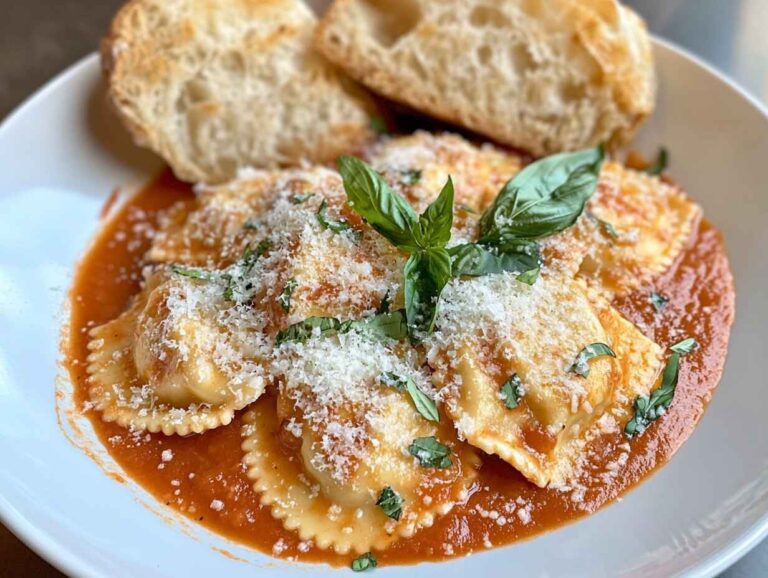
Red Sauce for Lobster Ravioli
A tangy, savory red sauce that complements the delicate flavors of lobster ravioli. This sauce, typically made with tomatoes, garlic, onions, and herbs, provides a balance of acidity and sweetness that enhances the richness of lobster, making it the perfect pairing for your ravioli dish.
- Total Time: 25 minutes
- Yield: 2-4 servings (depending on how much sauce is used per serving)
Ingredients
1 tablespoon olive oil,
1 medium onion finely chopped,
2–3 cloves garlic minced,
1 can (14.5 oz) crushed tomatoes,
1 tablespoon tomato paste,
1 teaspoon sugar (optional, to balance acidity),
1 teaspoon dried basil,
1 teaspoon dried oregano,
salt and pepper to taste,
fresh parsley for garnish (optional).
Instructions
- Heat Olive Oil: In a large saucepan, heat olive oil over medium heat.
- Cook Onion and Garlic: Add the chopped onion and sauté for 3-4 minutes, or until soft and translucent. Add the minced garlic and cook for another minute, stirring frequently to prevent burning.
- Add Tomatoes: Stir in the crushed tomatoes and tomato paste. Bring to a simmer.
- Season: Add sugar (optional), dried basil, oregano, salt, and pepper. Stir to combine.
- Simmer: Let the sauce simmer on low heat for 15-20 minutes, stirring occasionally, until it thickens and the flavors meld together.
- Finish and Serve: Taste and adjust seasoning if necessary. Pour the sauce over freshly cooked lobster ravioli and garnish with fresh parsley if desired.
Notes
For a spicier version, you can add a pinch of red pepper flakes or some fresh chili.
The sauce can be prepared in advance and stored in an airtight container in the refrigerator for up to 3 days.
You can substitute crushed tomatoes with tomato puree for a smoother texture.
- Prep Time: 5 minutes
- Cook Time: 20 minutes
- Category: Sauce
- Method: Stovetop
- Cuisine: Italian
- Diet: Vegetarian

